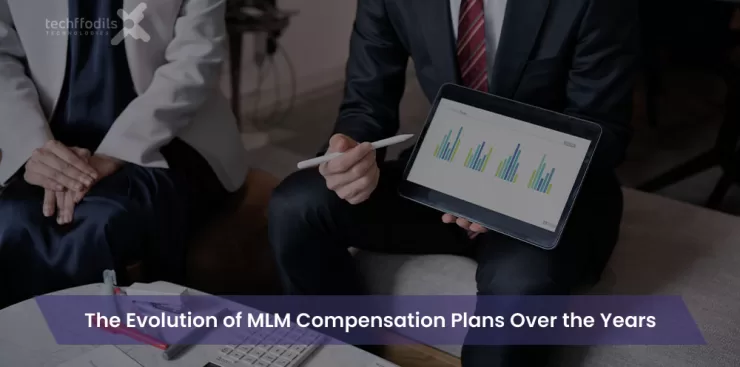If you are part of the MLM realm, you are aware of the fact that MLM compensation plans are the lifeblood of any multi level marketing business. They are the means that attract new distributors, incentivize the teams and in the end, decide who makes it and who cannot. However, these plans have not always looked the way they do today. Let’s go down memory lane and have a friendly chit chat about how the MLM compensation plans have transformed and what role the technology (like Lead MLM Software) is playing to structure their future.
The Humble Beginnings: The Birth of MLM Compensation Plans
Multilevel Marketing (MLM) compensation plan saga begins after the end of the Second World War. In 1945, the California Vitamin Company (renamed to Nutrilite later) created the first identified MLM compensation plan, laying the foundation for decades of innovation. The earliest form of direct selling were very straightforward: distributors got commissions from their own sales, also some share of the revenues flowing from the people they had brought in as downline, the latter term being a modern version of this concept.
Amway and Mary Kay were the two companies that made direct sales with a small profit accruals made up for recruiting new members by the 1950s and 60s. The incentive programs in those days were clear and simple, therefore, everyone quickly understood them, but over time, the industry has grown so the need for more appealing rewards has risen in parallel.
The 1970s-80s: Complexity Enters the Scene
With the increasing number of MLM companies in the 70s and 80s, the compensation plans also evolved. The Breakaway Plan was one of the first intricate plans. Under this plan, distributors would become the “breakaway” after accomplishing a number of sales, and in turn, starting their own lines and receive bonuses for both their and their team’s productivity.
But the intricacy did have negative aspects. New representatives may be confused by complex plans, and too often they will act solo until “the record was broken”. On the contrary, the Unilevel model was invented in the 1980s and became more popular. It was only then that the distributors were allowed to introduce the plan and sponsor as many people as they wanted on their very first level without any restrictions on the breadth of the commission reaching. Distributors only got a fixed percentage (e.g., 5%) for the first seven levels of the network.
The Matrix Plan (or forced matrix) was also unveiled during this time. It set very narrow boundaries in terms of both width (number of direct recruits) and depth (levels of downline), thus producing a certain more predictable structure that, however, occasionally could cause earning potential to be limited.
The 1990s-2000s: Hybridization and Globalization
As multi level marketing proliferated in most regions of the world, corporations started to implement hybrid remuneration systems that combine elements of unilevel, matrix, and breakaway schemes in order to make the rewards more reasonable and attractive to the people. Now, the emphasis was on compensating the promotion of both product and the new recruitment, with rewards added for the ascensions in the rank, for the leadership, and even for the profits made globally.
This time was also a time where technology began to be a part of the MLM industry. Early MLM software was designed to support companies in sales tracking, downline management, and commission calculation automation, which allowed for the implementation of more complicated plans to be made in a better way.
The 2010s: Digital Transformation and Customer Focus
The last 10 years completely altered the MLM industry by going digital. E-commerce integration enabled sellers to move their goods online and social media became the essential platform for both marketing and recruiting. Compensation plans followed suit to adapt to the new technological environment.
- Commission Structures : Distributors could now earn from online sales and social media marketing, not just face to face interactions.
- Customer Centric Rewards: Enterprises have started offering bigger commissions just to get real customers, notjust recruit new distributors. Loyalty programs and customer satisfaction levels have an impact on the compensation.
- Real Time Payments: Thanks to digital wallets and mobile apps, now it is possible for the distributors to monitor their profits and receive payments on the spot.
MLM software such as Lead MLM Software is now more than necessary, as it has been able to support and help in the smooth operation of a multiple compensation plans (matrix, binary, unilevel, monoline, and many others) and has been able to integrate even with e-commerce platforms and cryptocurrencies.
2020s and Beyond: Personalization, AI, and Compliance
The new world of MLM compensation has been characterized by customization, technology, and transparency. The following are the current trends:
- Personalized Compensation Plans :
No longer the epoch of one-size-fits-all. On the top of crushing it with new technology like AI and data analytics companies can now adjust compensation plans to the need of every distributor. For instance, a person, who is good at affiliate marketing, is more likely to get additional bonuses for co-building the team, while the best seller may earn higher direct sales commissions. This personalization not only increases motivation but is also something that makes distributors happy with them.
- AI-Powered Analytics and Lead Management
Modern MLM software, such as Lead MLM Software, is smart enough to do the forecasting of income for the distributors and also the offering of the profit from the suggested performance. AI, in this case, analyses the distributors’ performance and then provides the necessary corrections. It consists of the process of automating the track of the entire lead-to-customer lifecycle, which has the aim of making sales representatives’ work of the transformation of prospect customers into loyal customer supporters much easier.
- Compliance and Transparency
Due to the stricter regulations, multi-level marketing (MLM) enterprises are now mandated to provide income disclosure statements as well as a genuine income earning potential. Nowadays, the major factor in compensation plans is compliance, with clearly designed schemes and open and honest communication about what’s exactly possible (and what’s not).
- Global and Digital Payments
Global business is the norm for many MLMs. Modern compensation plans easily enable cross-border payments, multi-currency transactions, and even cryptocurrency integration, thus making it convenient for the teams all over the world to get paid quickly and safely.
- Sustainability and Social Responsibility
One emerging trend is giving people rewards for their environmentally aware actions and sustainable product advertising. It is the case that in the majority of structures, there are now certain parts of a person’s compensation which are for the designing of the ads for green products or the implementation of eco-friendly business practices.
How Lead MLM Software Powers Modern Compensation Plans
Considering all these changes, it is clear that strong MLM software has become unavoidable. Moreover, Lead MLM Software is distinguishable because it covers a majority of the compensation plans like matrix, binary, unilevel, monoline, investment, generation, donation, and others.
Furthermore, it is offers:
- E commerce integration: Market your products on the web, besides enjoying smooth stock tracking, selling and inventory management features.
- Multi currency and cryptocurrency support: · Pay distributors in any part of the world and in any currency.
- Real time dashboards: Distributors and admins can get instant access to data on sales, commissions, and the performance of the team.
- Lead management systems: Capture, nurture, and convert leads with automated workflows and personalized communication.
- Mobile apps: You can operate your company from anywhere with the option of both Android and iOS hence, having full control of your activities.
- Compliance tools: Guarantee compliance with regulations by reporting all the financials in a clear and customizable way.
A Glimpse Into the Future
Looking ahead, for great innovation in the coming years. AI will certainly take up even more personalization in the area of remuneration as well as performance optimization of teams. Technological innovation like the blockchain could even offer more transparency and security in payments. Furthermore, given that consumer expectations will change, compensation schemes might become even more customer-oriented, rewarding not only for the geniune product sales but also sustainable practices.
Final Thoughts: The Journey Continues
The evolution of MLM compensation plans is a rich tapestry of re-creation and invention. From the 1940s’ basic commission arrangements to the current highly personalized, technology-driven, and globally connected organizations’ complex commission structures, the industry has really grown up. As a distributor, a company owner, or even just someone who is curious about MLM, getting to know this development can steer you to good decisions – either by giving you a glimpse of the current situation or leading the way to a new trend.
With the new era, the problems are evolving. Looking to be a step further by investing in advanced solutions like Lead MLM Software is no longer an optional choice but an essential one. The right MLM software allows you to create, handle, and improve your MLM remuneration plan in a way that is suitable for the digital, new global, and customer-driven markets of today.


